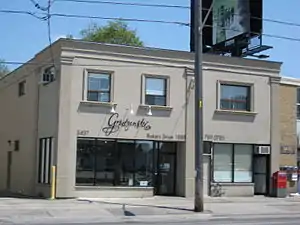Grodzinski Bakery
Grodzinski Bakery is a chain of kosher bakeries in London, England, where it is popularly known as "Grodz", and in Toronto.

Notable products
Grodinski's is particularly noted for its challah, a yeast bread eaten on the Sabbath, and for its babka, a cake made from a variant of yeast dough with a sweet filling traditionally eaten on the Sabbath.[1][2] Other popular products include bagels and cookies.[3][4][5]
History
Early years
About 1888,[4] Harris and Judith Grodzinski, bakers by trade, joined many members of the Jewish community in the Russian Empire in migrating westward from Voranava -- once a shtetl near Lida, currently in Belarus, and establishing themselves in the East End of London. There they hired kosher ovens and set out baking bilkelekh, thereby beginning a business that would grow from a trading barrow to a full-scale bakery founded in 1888.[6]
Harris and Judith were followed by Harris's nephew, Hyam Elyah Grodzinski, who had married Judith's sister Jessie. He had a bakery at 20, Cavell Street, then called Bedford Street, before moving to a shop in Fieldgate Street, Whitechapel, over which he lived.[6] Around the same time, the Fieldgate Street Great Synagogue was established next door, with the bakery's basement ovens extending beneath the synagogue.
Hyam Grodzinski was a businessman. His bakery at 20 Bedford Street thrived, whereas Harris and Judith were not doing so well. The two families swapped premises (including accommodation above) for a number of years until the Fieldgate Street bakery significantly improved. Later Hyam changed his name to Hyam Hyams and went into the cinema business with his sons Phil & Sid.
Domestic expansion
The bakery passed through two generations, managed successively by Harry and Judith's son Abraham (Abie) Grodzinski, who inherited the bakery at 18 on his father's untimely death at age 54; by Abie's widow, Bertha Jeidel, who had immigrated from Pfungstadt, Germany, and took over the business when Abie succumbed to the Spanish flu pandemic; and by their eldest children, Harry and Ruby Grodzinski, who took up the reins in 1930.
Grods prospered under Harry's and Ruby's tenure, beginning with the opening of a second location at 91 Dunsmure Road, Stamford Hill, to which baking was moved. A decade later, the bakery had expanded to six locations and even the original 31 Fieldgate Street location's demise in a 29 December 1940 German air raid could not halt expansion. By the mid-1960s Grodzinski was the largest kosher bakery in Europe, preparing both fine pastries and a range of bread, and adding to their retail business an advancing wholesale operation distributed through British retailers and department stores such as Selfridges, Marks & Spencer and Harrods.
In 2014 the bakery continued to have multiple locations in England.[4]
Overseas expansion
In 1999 the first Grodzinski bakery was opened in Toronto, continuing the family baking tradition into fourth and fifth generations. When it opened, the Edgware branch in London was managed by Tova Grodzinski, the great-great-granddaughter of the founders. In November 2003, during a 75th-anniversary celebration of the opening of the oldest surviving branch shop at 91 Dunsmure Road, a collection of historic photos and papers was unveiled, collected by current owner Jonathan Grodzinski.
In 2014 the bakery had two Toronto locations, one on Bathurst Street and the other in Thornhill.[4]
See also
References
- Sax, David (12 August 2002). "Last Bites: In times of sorrow, pass the babka". The New York Times. ProQuest 1705866931.
- Shaw, Rob (11 September 2004). "Challah". The Globe and Mail. ProQuest 383821069.
- Stewart, Victoria (10 June 2014). "London's best Filled bagels". Evening Standard. ProQuest 1534346343.
- Henry, Michele (24 December 2014). "Day 24: Pecan Tea Cookies from Grodzinski Bakery". Toronto Star. ProQuest 1639854290.
- "The Bagel". The Guardian. 5 August 1998. ProQuest 188205331.
- Louis Berk, Rachel Kolsky, Secret Whitechapel (Amberley Publishing, 2017), p. 118
External links
- Official website of J. Grodzinski and Daughters (London - Edgware, Stamford Hill)
- Official website of M & D Grodzinski (London - Golders Green, Hendon)
- Official website of Grodzinski Bakery (Toronto)
- 75 years of baking, from somethingjewish.co.uk
- The Grodzinsky/Grodzenchik Family from Lida, Belarus c.1785.